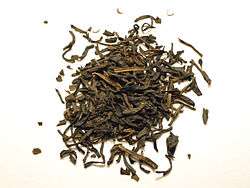Vietnamese tea

Traditionally, Vietnamese tea drinking is considered a hobby of the older, more learned members in households and in society in general. Tea drinking would accompany aristocratic activities such as composing poems, tending flowers, or simply appreciating nature. Vietnamese people generally favor lighter teas with flower fragrance, such as green tea or floral-scented white tea.
Vietnamese teas are produced in many areas that have been known for tea-house "retreats". For example, some are located amidst the immense tea forests of the Lamdong highlands, where there is a community of ancient Ruong houses built at the end of the 18th century. Vietnam has the world's oldest trees, dating back to 1000 years.[1]
Green tea is the most popular amongst Vietnamese people. In 2011 it accounted for over 63% of overall retail volume sales.[2] Vietnamese green teas have been largely unknown outside of mainland Asia until the present day. Vietnamese green teas have a lower content of caffeine compared to Chinese green teas but higher caffeine levels than Japanese green teas.[3] Recent free-enterprise initiatives are introducing these green teas to outside countries through new export activities.
The Vietnam Tea Association (VITA) was founded on July 19, 1998 and their goal is to protect and inform growers, consumers and business owners of Vietnamese teas.[4]
Types
- Lotus tea (trà sen) is a specialty product of the Vietnamese tea industry. Generally, high-quality green tea leaves are placed within lotus flowers for a day to acquire the scent, then the tea leaves are removed and packaged. A higher grade of lotus tea is made with lotus petals mixed in with high quality green tea leaves. Green tea style of Vietnam is to roll the leaves gently into crescents, and minimal handling. Vietnamese green teas are typically very potent. They are best brewed for most tastes for under 2 minutes using water temperature of 70 °C (160 °F). Beyond this time the tea will acquire a bitter taste that is nevertheless preferred by many tea lovers, as it reflects the potency of the tea leaves. Some tea lovers will brew 3-4 times from one set of leaves, preferring the narrower flavor range of the later brewings.
- Jasmine tea (trà nhài) is produced in two grades similar to lotus tea. Jasmine tea has a more profound aroma than lotus tea, and lotus tea has a sweeter taste. While lotus tea is considered a specialty and is reserved for events or special meals, jasmine tea is popular as a "chaser" for Vietnamese iced coffee, and is poured into the glass after the coffee is consumed, allowed to chill, and then enjoyed as a follow-up to the iced coffee in coffee shop cafes, particularly in the night life of major cities, where coffee shops are a popular social rendezvous on hot evenings.
- Trà atiso (artichoke tea) this is a herbal tea made from the leaves, root, stalk, and flower of the artichoke plant. The tea is a specialty of the Lam-Dong highland region, where an abundance of artichokes is grown.[5]
- Trà đắng (kuding tea), called bitter tea because of its taste. Due to its antioxidant activities, this bitter tea is prescribed to patients that suffer headaches, high blood pressure, cold fever and diabetes.[6]
- Chè nụ (Bud tea): made only from the bud of the tea flower.
- Chè vối: made from the buds and leaves of cleistocalyx operculatus tree.
Other common types of Vietnamese flower-infused tea are chrysanthemum tea (trà cúc), aglaia tea (trà ngâu, tea infused with the flower from the Aglaia duperreana plant), and trà sói, tea infused with the flower from the Chloranthaceae family.
References
- ↑ Wenner, Robert, "The Deep Roots of Vietnamese Tea: Culture, Production and Prospects for Development" (2011). Independent Study Project (ISP) Collection. Paper 1159. http://digitalcollections.sit.edu/isp_collection/1159
- ↑ "Tea in Vietnam". Euromonitor International Ltd. Retrieved 29 November 2012.
- ↑ Vuong,, Q; V., Nguyen, V. V., Golding, J. B., & Roach, P. D. (February 2011). "The content of bioactive constituents as a quality index for Vietnamese teas.". International Food Research Journal. 18 (1).
- ↑ CHÈ VIỆT NAM, CHÈ VIỆT NAM. "Che Viet".
- ↑
- ↑ Thuong,, P.,; Su, N., Ngoc, T., Hung, T., Dang, N., Thuan, N., & ... Oh, W (2009). "Antioxidant activity and principles of Vietnam bitter tea Ilex kudingcha". Food Chemistry. 113 (1): 139–145. doi:10.1016/j.foodchem.2008.07.041.
- "Antioxidant activity and principles of Vietnam bitter tea Ilex kudingcha". Food Chemistry. 113: 139–145. doi:10.1016/j.foodchem.2008.07.041.
| Wikimedia Commons has media related to Vietnamese green tea. |